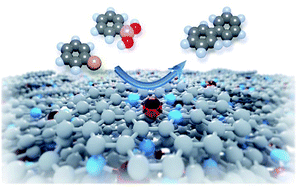Molecular engineered palladium single atom catalysts with an M-C1N3 subunit for Suzuki coupling†
Abstract
Single atom catalysis has emerged as a powerful technique for catalysis due to its outstanding performance and atom economy. Controlling the hybridization of the atom with its environment is crucial in determining the selectivity and/or yield of the reaction. However, the single atom environment is usually ill-defined and hard to predict because the pyrolysis process used in preparing SACs damages the original status of the precursors in the catalyst preparation. A molecular engineering approach to synthesize single atom catalysts (SACs) on a heterogeneous template provides a strategy to make SACs with a highly uniform coordinating environment. Herein, we report the preparation of a molecular engineered Pd single atom catalyst with a pre-defined M-N3C1 coordination (Pd-N3C1-SAC) using a structure-rigid Pd-N3C1 porphyrin as the precursor, which shows more efficient Suzuki coupling compared with the SAC with Pd-N4 coordination. The origin of the high activity of the Pd-N3C1-SAC is revealed through density functional theory calculations, where a lower reaction barrier for the rate-determining oxidative addition is identified.



 Please wait while we load your content...
Please wait while we load your content...